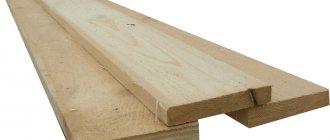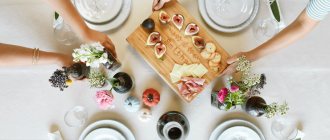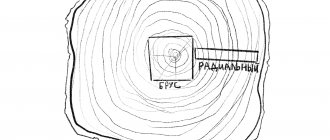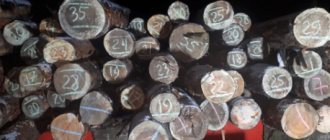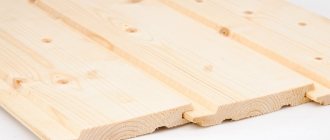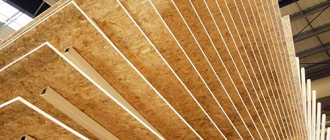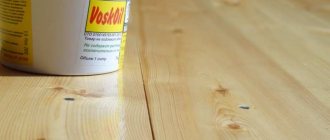Wood flooring remains the most common finishing method in apartments and private houses. Despite the popularity of the material, I have more than once encountered a situation where owners, planning to change floors, have little idea what types of boards exist and which ones they need specifically. When I see a desire to delve deeper into the issue, I think it would be useful to tell by what criteria floor boards differ.
Source archidea.com.ua
Manufacturing of edged boards
Edged boards are produced using special sawmill equipment. The simplest machines, so-called sawmills, use band saws to cut harvested logs along their entire length into a given board thickness.
- After cutting, the edges are cut to the required width.
- Modern equipment is highly automated and has laser sensors that determine the size and curvature of the log.
- The built-in computer calculates, depending on the diameter of the log, the optimal cutting to obtain the maximum yield of usable wood.
- First, the cross-section of the log is given the shape of a beam; it can have not only a square, but also a stepped shape, maximally inscribed in the diameter of the workpiece.
After this, the timber is sawn into boards of the required size. When sawing, in parallel with obtaining the desired material, beams, bars, boards of different thicknesses and two or four slabs can be obtained.
This technology makes it possible to increase the yield of usable wood.
Standard sizes
The board is characterized by three dimensions: thickness, width and length.
The dimensions of the edged board and the magnitude of deviations from them are established by the requirements of the international standard GOST 24454-80.
- The boards are manufactured in thicknesses of 16–250 mm, widths of 75–275 mm and lengths from 1 to 6.5 m.
- Boards thicker than 50 mm are often called timber or bars.
- Permissible deviations from thickness and width for values up to 32,
- from 40 to 100 and over 100 mm are ±1, ±2, ±3 mm, respectively.
- Increments from the minimum length of 1 m are made in increments of 0.25 m, unless otherwise specified by the customer.
- The permissible deviation in length should be in the range from -20 to + 50 mm.
Moldings
The following materials are in demand among molded products:
- Lining. Cladding profiled board, up to 22 mm thick. For interior decoration, use lining no thicker than 12-16 mm. Parameters of façade lining: 16-22 mm.
- Rail. It is obtained after sawing the board; the standard section is set to 25x25 or 50x50 mm.
- Skirting board. Rail profiled in different ways. It is included in a variety of profile parts; dimensions vary within a fairly wide range.
Source zhkpribrezhny.rf
About sawing wood for different lumber in the following video:
Sawing, processing boards
The cutting method affects the strength of the resulting board, the percentage of usable wood, texture and cost. Obviously, the higher the yield, the more profitable the production becomes.
The most rational methods of cutting to obtain edged boards:
- Tangential. With this method, the cut line is shifted from the core, the cut is made tangentially to the circumferences of the growth rings, hence the name. The boards have low strength, but have a beautiful texture.
- With the radial method, the cut passes through the center. These are the strongest boards due to the fact that the direction of the fibers coincides with the direction of the annual rings. Their cost is also the highest.
- Semi-radial cutting is made at an angle of 45° to the annual rings. The strength is lower than with the radial method, but the wood yield is higher. After sawing, the boards are dried.
- Drying boards can occur in various ways. The cheapest of them is atmospheric drying. But it requires a lot of time and free space to place stacks of dried material.
More common is drying in convection chambers with automatic temperature and humidity control; this method does not require large expenses.
If it is necessary to reduce drying time, then vacuum chambers are used.
Other methods are also used - drying in microwave ovens, in infrared radiation installations, etc.
After drying, edged boards are most often planed on one or both sides. Planed edged boards are the highest quality timber with guaranteed dimensions.
Classification
There are many characteristics that divide the main types of lumber into groups. The most popular classification is by type of cut:
- Board.
- Beam.
- Bar.
- Sleeper.
- Gorbyl.
There are also edged and unedged materials. In the first case, the workpiece is processed from all sides, and in the second - only from one. There are mixed varieties of them.
According to the cutting method, the workpieces are divided into radial and tangential. This classification depends on the positioning of the cut relative to the tree's growth rings.
Another important classification factor is humidity. Dry materials have this indicator at the level of 8-10%. Such products are solid and are used for arranging, for example, flooring. Universal lumber has a moisture content of 12-15%. These are blanks for skirting boards, platbands, timber. Exterior lumber has a moisture content greater than 18%. They are suitable for cladding facades and creating a rafter system.
Grade
Boards have their own inherent defects - these are wood defects, deviations from dimensions, curvature, the presence of knots, wane.
Grades assigned to softwood edged boards according to GOST 8486-86:
- Selected grade, used for finishing work and the manufacture of luxury furniture.
- Only small cracks up to 100 mm are allowed, and no more than two small knots per linear meter.
- First grade: cracks up to 150 mm, number of knots no more than 3.
- Second grade: cracks up to 200 mm, knots up to four or larger in diameter.
- The first and second grades are used mainly for the construction of wooden cottages.
- Third grade: the same defects are allowed, plus the presence of fungal mold;
- Fourth grade: defects are not standardized, a prerequisite is the integrity of the material.
The third and fourth grades are used for the manufacture of flooring, formwork, transport containers, and pallets.
For selected grades 1 and 2, the longitudinal warpage of boards should not exceed 2%, for grade 3 – 4%, for grade 5 it is not standardized.
The moisture content of selected edged boards, grades 1, 2 and 3 after drying should not exceed 22%; the moisture content of grade 4 is not standardized.
Problems of purchasing quality lumber
Initially, you should reveal the main pains, as it is fashionable to say in modern language, or the customer’s problems when buying lumber!
- Availability of the required assortment in retail outlets. As a rule, most markets, construction bases and markets sell the most popular material. Beams and boards, wooden slats, various slabs for cladding and rough finishing. But more often these are materials of the 2nd and 3rd grade, used in construction and rough work, the range of which is almost static. The choice is possible only by appearance and price. Come, look, like it or not, and buy if the product meets your requirements. It is rare to find a complete range of materials used in construction and finishing. Only to order with waiting and increasing prices. If urgent purchases are necessary, products that are in stock are selected. And here massive errors are possible, which only benefit the seller;
- Inconsistency between quality and price. Products on display, samples with price tags and characteristics, often of good quality. But when purchasing materials in bulk, the goods are loaded into your car in bulk, with the help of local loaders. Yes, it will be the timber and board that you ordered, but their quality may be very far from what is desired. Storing lumber in a damp warehouse, improper unloading, too fresh wood... all this affects the quality. You can often come across boards with cracks or mold, bent bars and twisted slats, which are not only inconvenient to work with, but often simply impossible. Naturally, in the total mass of such products there is enough material that does not meet the standards, and therefore, when rejected at the work site, up to 30% can go to waste, which will necessarily affect the final cost of the product;
- Outright deception and fraud. Only 10-15% of buyers understand the standards and regulations and check the compliance of the purchased products with them. And if the customer sees a board or timber of the third grade instead of the ordered second, he simply will not pay for the purchase. The rest of the buyers do not pay attention to many defects, such as sawing and machining errors, dimensions, non-compliance with grades according to GOST and other standards. Few people measure the size of cracks and their number, knots and wormholes, and other defects that regulate the grade and are responsible for the technical characteristics of the building material. And this is an excellent incentive for a good half of sellers to sell what they need to sell, and not what the customer needs to buy;
- High cost of lumber. Assessing all the problems of buying lumber, it becomes clear that only in the last points the price of the product increases, and not only by 30% or 50%, but sometimes several times. Initially, the price already includes delivery from the felling site to the sawing and storage site, the cost of processing and drying, if any, several markups between wholesale warehouses, retail and the end consumer, as well as the obligatory corruption component, salaries, rent and taxes. Therefore, there is little that can be influenced here, since these pricing factors are present at every point of sale. The only thing you can do on your own is to try to choose a quality material by assessing the appearance and technical parameters of the samples according to established standards. This is difficult to do, but if you want to optimize your own expenses, you need to pay attention to these requirements!
Hardness and density of wood
These are important indicators when choosing boards for construction, furniture making, decorative cladding, carved products, etc.
Table 1 shows the values of hardness and density for the most common wood species in Russia.
Table 1
Lining
One of the most popular types of boards today is lining. These types of lumber are used for cladding indoors and outdoors. Even in technical documents this type of product is called cladding board.
The profile of the lining may be different. The material from which it is produced is also characterized by a wide range. When choosing it, the operating conditions are taken into account. Coniferous and soft hardwoods are suitable for dry rooms.
If this is a bathhouse, then the use of resinous types of wood is not allowed. Otherwise, you may get burned. Hardwood is used for outdoor cladding. They are treated with various substances to extend their service life.
Types and species of trees
Conifers. These include:
- Spruce;
- Pine;
- Larch;
- Cedar;
- Fir.
Coniferous edged boards made from spruce and pine have a wide variety of applications: internal and external cladding of residential premises and outbuildings, for the manufacture of packaging, containers, formwork for foundations, subfloors, floors, roof sheathing, etc.
The material has earned popularity due to its good structural properties - it is easy to process, has satisfactory strength and resistance to rotting, and an attractive appearance.
- These trees are widespread throughout Russia. Spruce is slightly inferior to pine in strength and appearance due to the larger number of knots.
- Larch - has dense wood, is very resistant to moisture, and practically does not rot. Buildings made from it can last hundreds of years.
- Larch is used for the construction of house frames, utility rooms, floor and roof beams, open verandas, and stairs.
- Fir has more knots than even spruce - this reduces its strength and worsens its appearance.
- Cedar boards are less commonly made; it is mainly common in Siberia. This is a durable, soft wood, easy to work with, and resistant to moisture.
It should be taken into account that lumber made from pine and spruce release resin, especially when heated. Therefore, they are not recommended for finishing rooms with high temperatures - baths, saunas, etc.
timber
The appearance of lumber, for obvious reasons, depends not only on the type of tree. The processing process leaves its mark on the characteristics of each product. One of the most common is timber. It is used in the construction of both cladding and independent structures and buildings.
There are several types of timber. The simple type (non-profile) looks like a log processed on 4 sides. But other types of similar products are also made. Profiled timber is produced in a clearly defined form. Most often it is a rectangle with a notch at the bottom. Good-quality houses and cottages are assembled from such lumber. They hold heat well and have a low percentage of deformation (if the timber is properly processed). The profile can be very different.
There is also glued laminated timber. It is assembled from lamellas and has improved characteristics. It practically does not shrink and does not crack. Today, rounded timber is also in demand. It has high aesthetic qualities.
Deciduous trees
- Aspen;
- Birch;
- Beech;
- Oak;
- Ash;
- Maple.
Edged aspen boards are not afraid of moisture, so its main use is interior and exterior decoration, bathhouses, and well log houses. Well processed. Dried aspen is not inferior in strength to coniferous boards.
- The core of aspen logs is often loose and rotten, so the yield of suitable products is low.
- Birch, along with aspen, is a soft wood; it has an attractive appearance, but is susceptible to rotting, so it is used mainly for interior decoration. To increase resistance to moisture, birch boards are, if necessary, impregnated with an antiseptic.
- Oak edged boards, along with beech, ash and maple, are hard and durable materials. Processing oak, due to its hardness, is associated with some difficulties.
Boards of these species have a beautiful appearance. They are used to create decorative panels, interior decoration of hotels, restaurants, bars: counters, counters, antique-style furniture for luxury premises.
Gorbyl
In the process of making timber or boards, a slab is obtained. This is the side of the log. These lumber are convex on one side and flat on the other.
This material is also in demand today. The slab is quite suitable for arranging temporary buildings and technical premises.
Also today it has become quite popular to perform decorative finishing using this type of lumber. The slab is processed mechanically only on the single-slope side, so before installation work it must be impregnated with a special antiseptic. Otherwise, in a couple of years the croaker will turn into dust. The relatively low cost makes it in demand. New areas are emerging in which this material is used.
Choosing edged boards
Which edged board to choose is an important question, since the quality and cost of the material must correspond to the goal.
First of all, you need to determine the preferred types of wood, the required dimensions, and the strength of the board.
You should not purchase lumber from random sellers with an unconfirmed reputation. In difficult cases, it is best to seek advice from specialists; such services are often provided by contractor firms.
How to choose the right variety
Once the wood arrives at the warehouse, it is no longer checked for defects. When purchasing timber, a person must rely on regulatory control and his own knowledge. To make the right choice, you need to study the varietal characteristics and rely only on them.
Often, instead of digital values, wood grades are marked with the letters A, B, C. These designations correspond to the number of defects in the product.
Sometimes you may encounter the fact that a selective class is marked with the number 0, or with an ordinary horizontal line. The first class (1) is indicated by a dot, the second by two dots or two slashes. Third grade (3), by analogy, 3 dots or 3 vertical stripes. Each manufacturer labels their products differently.
Tips for choosing lumber:
If the products are required for outdoor use, then you should pay attention to the absence of deep cracks on them. As for knots, they significantly reduce the mechanical characteristics of wood. Closely spaced growth rings are a sign of material strength
If the rings run parallel to each other, then you can safely make furniture from such wood. Hardwoods are suitable for constructing stairs and flooring. You should not use selected grade timber where second- or third-grade raw materials will do.
You can determine the quality and type of wood visually, but it is better to purchase timber from a trusted supplier.
